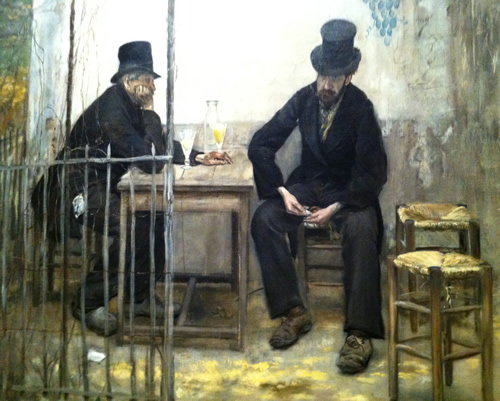In 1880, on the terraces and boulevards of Montmartre and the Latin district, there was a time called “the green hour” that went on every evening at about 6 p.m.
Men and women, young and old, from the chic saloons of the grand cafés to the worker’s cafés, participated in the green hour, which was the time to drink absinthe.
Absinthe in Paris
In order to taste absinthe properly you have to follow a particular ritual in preparation, which the French of this magnificent era adopted with pleasure. You put a measure of absinthe in a shot glass and place it under one of the spouts of the fountain. Once open, the tap allows a stream of iced water to flow over the sugar (placed previously on the glass), in a special spoon of finely worked silver. The water thus slowly dissolves the sugar in the drink and joins with the bitter taste of the plant.

The practice of drinking absinthe was introduced by soldiers returning from the conquest of Algeria. Absinthe was in fact used for therapeutic purposes to treat soldiers and colonists against typhoid and malaria. On returning to France, the officers of the Battalions of Africa didn’t miss the chance to start the absinthe craze by parading around with a glass in their hand on the terraces of the Grands Boulevards cafés. This cool, bitter drink, unknown up till then became one of the most drinked alcools.
At the beginning of the reign of Napoleon III and until 1870, it was especially the bourgeoisie who liked to drink this drink with its original taste and asserting character. An expensive drink, it was essentially served as an aperitif in the great Parisian dinners or in fashionable bourgeois cafés.
Distilled up to 70°, absinthe was strongly present in all intellectual and artistic meetings in Paris of this era. Painters, writers and artists looked for inspiration by sipping absinthe without moderation.
In the Montmartre cafés, at the Martyrs brasserie, at Rat Mort or Chat Noir, this modern exiting drink confused and charmed the impressionists, Degas, Manet, Van Gogh and especially Gaugin. The latter wrote: “I am sitting at my door, smoking a cigarette and sipping my absinthe, and I appreciate each day without worrying about the rest of the world”. All the painters dedicated one or more paintings to him.
Absinthe became equally the Muse of the green-eyed writers such as Oscar Wilde, Rimbaud, Baudelaire, Joyce, Hemingway, Edgar Poe.
“Absinthe makes you forget, but makes you pay in migraines. The first glass shows you things as you want to see them, the second shows you things as they are not; after the third, you see them as they really are.” describes Oscar Wilde who called absinthe the green fairy.
With the development of cafés, bistrots and cabarets, absinthe quickly became widespread, and in 1880 the national drink when the price of absinthe became more expensive than wine.
Accused of being the origin of delirium crises, Absinthe was finally banned in 1915 with the war. It was only 100 years later that his sale was once again authorized.